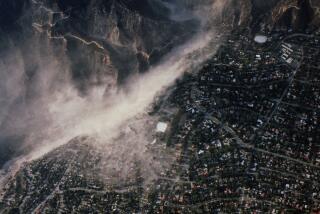Practicing for the Big One : Quakes: State brings private businesses and public agencies together for weeklong session. Participants say teamwork is a key to preparedness.
SAN LUIS OBISPO — Memories of the 6.8-magnitude Northridge earthquake were still rattling through Carl Alexander’s head Thursday when he found himself worrying once more about collapsing buildings and motorists trapped beneath fallen freeway bridges.
Alexander is a captain with the tiny Warner Bros. Studios Fire Department in Burbank, where sound stages suffered plenty of real damage Jan. 17. Happily for him, the destruction was only imaginary this time.
He was among 65 safety officials from cities and businesses around the state who have gathered this week at a World War II Army camp near San Luis Obispo to learn how to keep their wits about them when the Big One really hits.
A realistic earthquake drill staged Thursday was the highlight of a weeklong seminar being conducted by a little-known state agency called the California Specialized Training Institute. Since 1983, the school has trained more than 5,400 emergency managers how to react after a major temblor.
But state officials say last month’s Northridge quake has prompted them to sharply underscore the need for gut-wrenching decisions that public officials must make during--and after--an earthquake.
Which people do you pull from the rubble first when an apartment building collapses and whose screams for help do you ignore? Later, who do you let into the tent city shelters you’ve set up and who do you kick out?
“It’s a hard decision to make when you’re standing in front of a collapsed building,” said James Petroni, a former arson investigator who helped create the earthquake training program in 1985. “And with shelters are you creating a short-term solution or a long-term problem?”
If there are not enough rescuers to go around, they must be sent where they can do the most good. And that means officials must have a good enough grasp of the disaster to know where to send rescuers where they are needed most, he said.
Petroni said the Northridge quake was the state’s first major disaster to feel the impact of the growing problem of homelessness and its effect on emergency relief efforts.
Institute students faced many of those questions during Thursday’s mock earthquake--an imaginary 7.1 shaker in the imaginary town of Santa Luisa del Mar.
The students were required to set up an emergency command post and size up the scope of the disaster as they decided how best to allocate Santa Luisa’s firefighters, police and utility workers for rescue work.
Diane Marquez, a veteran dispatcher with the Montebello Police Department, was one of those hunched over a map showing trouble spots in the fictional city. She said the weeklong exercise was pinpointing some potential trouble spots in her department’s emergency dispatching procedure, too. “I’m going to work on it back home,” Marquez said.
Lt. Charles Roper, newly named chief of tactical planning for the Los Angeles Police Department, played the role of command post chief during Thursday’s drill. It was an eye-opener for him, too.
“I’ve personally never worked closely with the Fire Department before,” he said. “Now I see some of their problems from their perspective.”
Safety experts from private businesses were surprised to learn how their companies can benefit from better communications with public agencies during earthquakes.
Deborah Miller, a safety coordinator with Kaiser Permanente--which lost a Granada Hills medical clinic in last month’s quake--said hospitals run by her company are setting up emergency command posts modeled after those run by local authorities.
Universal Studios emergency services manager David Geary said he picked up ideas for better post-quake coordination with Los Angeles city and county officials. “We want our procedures to be as similar as possible to what government is doing,” he said.
State officials say that is a good idea for other companies, too.
Firms that are prepared to handle their own emergencies during a quake not only relieve pressure on public agencies but can be a potential resource that local authorities can draw on in a pinch, said John Mirolla, director of the institute.
As for Alexander, he said he will have a new view of earthquake rescue work when he returns next week to his studio firetruck.
“If an earthquake ever happens to me again, I’ll still just be a small cog in a big machine,” he said as he penciled in reports of mock bridge failures, mall collapses and people trapped onto a huge wall chart.
“But I’ll sure know I have the capability of communicating with my superiors.”
More to Read
Sign up for Essential California
The most important California stories and recommendations in your inbox every morning.
You may occasionally receive promotional content from the Los Angeles Times.











